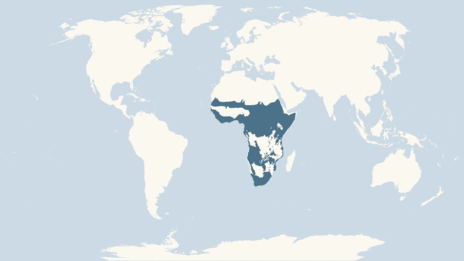African Fish Eagle
The African fish eagle is a large bird, and the female, at 3.2–3.6 kg is larger than the male, at 2.0–2.5 kg. Males usually have a wingspan of 2 m, while females have a wingspan of 2.4 m. The body length is 63–75 cm. The adult is very distinctive in appearance with a mostly brown body with a white head like the bald eagle and large, powerful, black wings. The head, breast, and tail are snow white, with the exception of the featherless face, which is yellow. The eyes are dark brown in colour. The hook-shaped beak is yellow with a black tip. The plumage of the juvenile is brown in colour, and the eyes are paler compared to the adult. The feet have rough soles and are equipped with powerful talons to enable the eagle to grasp slippery aquatic prey. The call, shriller when uttered by males, is a weee-ah, hyo-hyo or a heee-ah, heeah-heeah.

Habitat
They are found near freshwater lakes, reservoirs, and rivers, although they can sometimes be found near the coast at the mouths of rivers or lagoons. They are indigenous to sub-Saharan Africa, ranging over most of continental Africa south of the Sahara Desert. Several examples of places where they may be resident include South Africa and Namibia, Botswana, and Lake Malawi bordering Malawi, Tanzania, and Mozambique.

The African fish eagle is thought to occur in substantial numbers around the locations of Lake Victoria and other large lakes in central Africa, particularly the Rift Valley lakes. This is a generalist species, requiring only open water with sufficient prey and a good perch, as evidenced by the number of habitat types in which this species may be found, including grassland, swamps, marshes, tropical rainforest, fynbos, and even desert-bordering coastlines, such as that of Namibia. The African fish eagle is absent from arid areas with little surface water.
Diet
The African fish eagle mainly feeds on fish, which it swoops down upon from a perch in a tree, snatching the prey from the water with its large, clawed talons. The eagle then flies back to its perch to eat its catch. Like other sea eagles, the African fish eagle has structures on its toes called spiricules that allow it to grasp fish and other slippery prey. Should the African fish eagle catch prey over ten times their own body weight, it is too heavy to allow the eagle to get lift, so it instead drags the fish across the surface of the water until it reaches the shore. If it catches a fish too heavy to allow the eagle to sustain flight, it will drop into the water and paddle to the nearest shore with its wings. The African fish eagle is known to steal the catch of other bird species in a behaviour known as kleptoparasitism. It also feeds on birds, especially waterbirds such as ducks, greater and lesser flamingos, small turtles and terrapins, baby crocodiles, lizards, frogs, and carrion. Occasionally, it may even carry off mammals, such as hyraxes and monkeys. It has also been observed feeding on domestic fowl (chickens).
Breeding
African fish eagles breed during the dry season, when water levels are low. They are believed to mate for life. Pairs often maintain two or more nests, which they frequently reuse. Because nests are reused and built upon over the years, they can grow quite large, some reaching 2 m across and 1.2 m deep. The nests are placed in a large tree and are built mostly of sticks and other pieces of wood. The female lays one to three eggs, which are primarily white with a few reddish speckles. Incubation is mostly done by the female, but the male incubates when the female leaves to hunt. Incubation lasts for 42 to 45 days before the chicks hatch. Siblicide does not normally occur in this species, and the parents often successfully rear two or three chicks. Chicks fledge around 70-75 days old. Postfledgling dependence lasts up to three months, whereafter the juveniles become nomadic, and may congregate in groups away from territorial adults. Those that survive their first year have a life expectancy of some 12-24 years
Population
According to the IUCN Red List, they are classed as Least Concern(LC). The population is suspected to be stable in the absence of evidence for any declines or substantial threats. The number of mature individuals is unknown.
Threats
The species is not known to be directly persecuted by humans, even though it is very numerous and probably a direct competitor for fish. Neither is it particularly affected by habitat loss. In some regions a build-up of organochlorine pesticides in water bodies and therefore in their fish prey, could result in eggshell thinning. This has been recorded in South Africa and Zimbabwe but has not yet had any significant impact on the population.
Conservation
There are currently no conservation actions for this species.